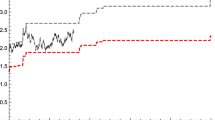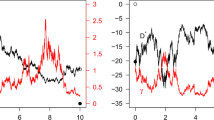Abstract
A “buy low, sell high” trading practice is modeled as an optimal stopping problem in this paper. Because its award function lacks sufficient smoothness, traditional free-boundary approach with solution in form of integral equations is not available. Therefore, we design a backward recursive algorithm computing the value function to determine the stopping boundary. Besides, a new PDE technique is developed to conclude the special cases with positive drift. Finally, groups of comparison tests are designed to investigate the model parameters setting as well as the feasibility and profitability of the trading strategy.




Similar content being viewed by others
References
Agram, N., Bachouch, A., Oksendal, B., & Proske, F. (2019). Singular control optimal stopping of memory mean-field processes. SIAM Journal on Mathematical Analysis, 40(1), 450–469.
Bather, J. (1970). Optimal stopping problems for Brownian motion. Advances in Applied Probability, 2(2), 259–286.
Boyce, W. M. (1970). Stopping rules for selling bonds. The Bell Journal of Economics and Management Science, 1(1), 27–53.
Chow, Y. S., Robbins, H., & Siegmund, D. (1971). Great expectations: The theory of optimal stopping. Boston, MA: Houghton Mifflin.
Du Toit, J., & Peskir, G. (2007). The trap of complacency in predicting the maximum. The Annals of Applied Probability, 35, 340–365.
Du Toit, J., & Peskir, G. (2008). Predicting the time of the ultimate maximum for Brownian motion with drift. In A. Sarychev, A. Shiryaev, M. Guerra, & M. R. Grossinho (Eds.), Mathematical control theory and finance (pp. 95–112). Berlin: Springer.
Du Toit, J., & Peskir, G. (2009). Selling a stock at the ultimate maximum. The Annals of Applied Probability, 19(3), 983–1014.
Du Toit, J., Peskir, G., & Shiryaev, A. N. (2008). Predicting the last zero of Brownian motion with drift. Stochastics, 80, 229–245.
Engelbert, H. J. (1973). On the theory of optimal stopping rules for Markov processes. Theory of Probability and Its Applications, 18, 304–311.
Guo, X., & Zhang, Q. (2005). Optimal selling rules in a regime switching. IEEE Transactions on Automatic Control, 50, 1450–1455.
Hull, J. C. (2014). Options, futures, and other derivatives (9th ed.). Englewood Cliffs, NJ: Prentice Hall.
Liu, Y., & Privault, N. (2017). Selling at the ultimate maximum in a regime switching model. International Journal of Theoretical and Applied Finance, 20(3), 1–27.
Liu, Y., & Privault, N. (2018). A recursive algorithm for selling at the ultimate maximum in regime-switching models. Methodology and Computing in Applied Probability, 20(1), 369–384.
Oksendal, B. (2003). Stochastic differential equation (6th ed.). Berlin: Springer.
Peskir, G. (2019). Optimal stopping times. General theory for the discrete-time case. The Annals of Applied Probability, 29(1), 505C530.
Peskir, G., & Shiryaev, A. (2006). Optimal stopping and free-boundary problems. Lectures in Mathematics ETH Zürich. Birkhäuser Verlag, Basel.
Shiryaev, A. N. (1978). Optimal stopping rules. New York, NY: Springer.
Shiryaev, A. N. (2019). Optimal stopping times. General theory for the discrete-time case. In A. N. Shiryaev (Ed.), Probability theory and stochastic modelling, stochastic disorder problems (pp. 57–73).
Shiryaev, A. N., Xu, Z. Q., & Zhou, X. Y. (2008). Thou shalt buy and hold. Quantitative Finance, 8, 765–776.
Yam, S. C. P., Yung, S. P., & Zhou, W. (2009). Two rationales behind the buy-and-hold or sell-at-once strategy. Journal of Applied Probability, 46, 651–668.
Yam, S. C. P., Yung, S. P., & Zhou, W. (2013). A unifed Bang-Bang principle with respect to R-invariant performance benchmarks. Theory of Probability & Its Applications, 57, 357–366.
Yang, A. J., Liu, Y., Xiang, J., & Yang, H. Q. (2016). Optimal buying at the global minimum in a regime switching model. Mathematical Social Sciences, 84, 50–55.
Yao, D. D., Zhang, Q., & Zhou, X. Y. (2006). A regime-switching model for European options. International Series in Operation Research and Management Science, 94, 281–300.
Zhang, Q. (2001). Stock trading: An optimal selling rule. SIAM Journal on Control and Optimization, 40, 64–87.
Author information
Authors and Affiliations
Corresponding author
Additional information
Publisher's Note
Springer Nature remains neutral with regard to jurisdictional claims in published maps and institutional affiliations.
This research is supported by Humanities and Social Science Foundation of Ministry of Education of China No. 18YJC910001, Jiangsu Natural Science Foundation No. BK20180852, China Postdoctoral Science Foundation No. 2017M621637, Natural Science Foundation of China Nos. 71673117 and 71701082, National Statistical Science Research Project of China No. 2017LY45, Startup Fundation of UJS No. 17JDG051, University Philosophy and Social Science Research Project of Jiangsu Province No. 2018SJA0130 and Jiangsu Qinglan Project (2017).
Appendix
Appendix

Rights and permissions
About this article
Cite this article
Liu, Y., Yang, A., Zhang, J. et al. An Optimal Stopping Problem of Detecting Entry Points for Trading Modeled by Geometric Brownian Motion. Comput Econ 55, 827–843 (2020). https://doi.org/10.1007/s10614-019-09915-w
Accepted:
Published:
Issue Date:
DOI: https://doi.org/10.1007/s10614-019-09915-w




